Updated: May 1, 2019
If you are in the market for a robotic vacuum to help keep your floors clean, the iRobot Roomba is a popular choice.
With many different models to choose from the choice can become difficult. This review will compare the top of the line for the 600 series, the Roomba 690, with the top of the line for the 800 series, the Roomba 890.
Each of these models had advantages and disadvantages. We will show you all of them and give you a rundown of each robot individually. To get all the details, continue reading the article below. If you just want to know our pick and get on with your day: we have selected the Roomba 890 as the better option. The key reason is that 890’s brushless rollers make a huge difference when it comes to maintenance.
Contents
- 1 The Differences between Roomba 690 and 890
- 2 Similarities between the Two
- 3 Roomba 690 vs 890 Comparison Chart
- 4 Comparison by Category
- 5 Review of the Roomba 690
- 6 Review of the Roomba 890
- 7 Frequently Asked Questions
- 7.1 Q: Do I need wifi in my house to use these Roombas?
- 7.2 Q: Will the Roomba get caught on cords and carpet fringe?
- 7.3 Q: I’ve heard that the Roomba won’t clean dark colored flooring.
- 7.4 Q: We have expensive luxury flooring, will the Roomba damage them?
- 7.5 Q: The Roomba cleaned a room I didn’t want it too, how can I prevent this?
- 7.6 Q: Will the Roomba transition between hardwood floors and thick braided rugs?
- 7.7 Q: Will the Roomba mark or mar my white baseboards?
- 7.8 Q: My cat tracks kitty litter around the house, if I get a Roomba, will it help?
- 7.9 Q: Does the Roomba automatically recharge when it it’s batteries are dead?
- 8 What We Like about The Roomba 690
- 9 What We Like about The Roomba 890
- 10 The Bottom Line
The Differences between Roomba 690 and 890
Knowing what separates these two units will help make your decision easier. You may be surprised to learn the features missing from one or the other model. Not every feature is a must, and we will try to help you decide.
Your tastes, preferences, and budget will go a long way to making the final choice for you. These differences will help with that decision.
- The Roomba 890 makes use of a HEPA filter. The 690 uses the AeroVac filtration.
- The 890 model takes advantage of the AeroForce vacuuming technology while the 690 utilizes the AereoVac technology.
- The Roomba 690 does not have a full bin indicator. The 890 will indicate when the bin is full and needs emptying.
- The 890 unit has low maintenance brushless rollers. The 690 unit has traditional rotating bristle brushes.
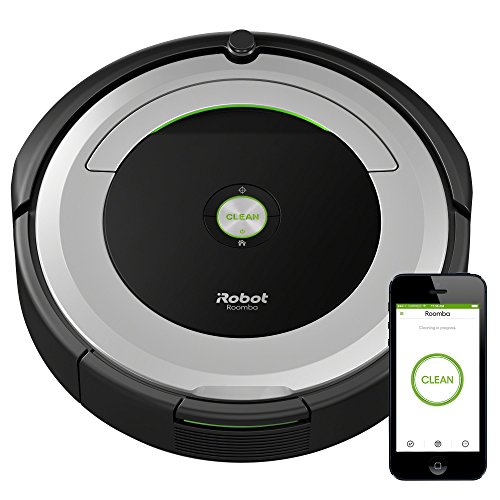
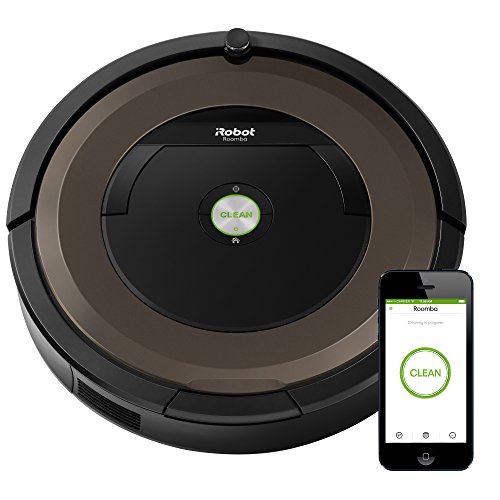
Similarities between the Two
When deciding on a robot vacuum, you may need to know if one model can do the same things as another model. This rundown will show you the similarities between the Roomba 890 and 690 models.
- Each model uses the original iAdapt tech for mapping and navigation.
- Both the 690 and the 890 connect to your home network through WiFi.
- The wireless connection allows both units to support the iRobot app.
- Each robot vacuum can be scheduled for cleaning dates and times in the future.
- Using the iHome setup, you can connect both models to your smart home using Amazon Alexa or Google Assistant for voice-activated controls.
- Each of the models will sense when the battery is in need of a recharge and find its way back to the docking station.
- You can use the iHome app to make the 690 and 890 dock and recharge manually.
- The 690, as well as the 890, come with lithium-ion battery packs.
- Each of the models reviewed today are able to spot clean when and where you direct them.
Roomba 690 vs 890 Comparison Chart
We present to you the comparison chart so that you can see both models of robotic vacuums side by side. Your decision will come down to having a vacuum that can not only clean your floors but one that can also perform with features you desire.
| Roomba 690 | Roomba 890 | |
| Navigation | iAdapt | iAdapt |
| Filter | AereoVac | HEPA |
| WiFi Enabled | Yes | Yes |
| Vacuum Technology | AeroVac | AeroForce |
| Full Bin Indicator | No | Yes |
| Extractor Type | Bristle Brush Bars | Debris Extractor |
| Scheduling | Yes | Yes |
| Automatic Recharge | Yes | Yes |
| Forced Docking | Yes | Yes |
| Battery Type | Lithium-Ion | Lithium-Ion |
| Remote Control | iHome App | iHome App |
| Voice Control | Yes | Yes |
| Virtual Wall Barriers | 1 | 1 |
| Price | Check on Amazon | Check on Amazon |
Comparison by Category
Both models have a lot in common, and it really is the differences that will make your choice between these two the most difficult. Below we will attempt to explain the features of the vacuums in greater detail to allow you to make a more educated decision.
The Roomba 690 and the 890 both make use of the iAdapt navigation and mapping software. When active, the robots will run through and map the area for obstacles such as furniture, walls, and appliances.
Even withiAdapt software running the show, the navigation leaves a bit to be desired.The robots will clean the entire floor, but you may feel like some areas didn’t get touched. This is because the route to clean the floors is sporadic and random.
A human would go from one side of the room to the other in relatively straight lines. With the Roomba models here, they tend to make a more random pattern throughout the entire area.
Bottom Line: Your floors will be cleaned thoroughly, even if you see the robot in various areas in weird patterns.
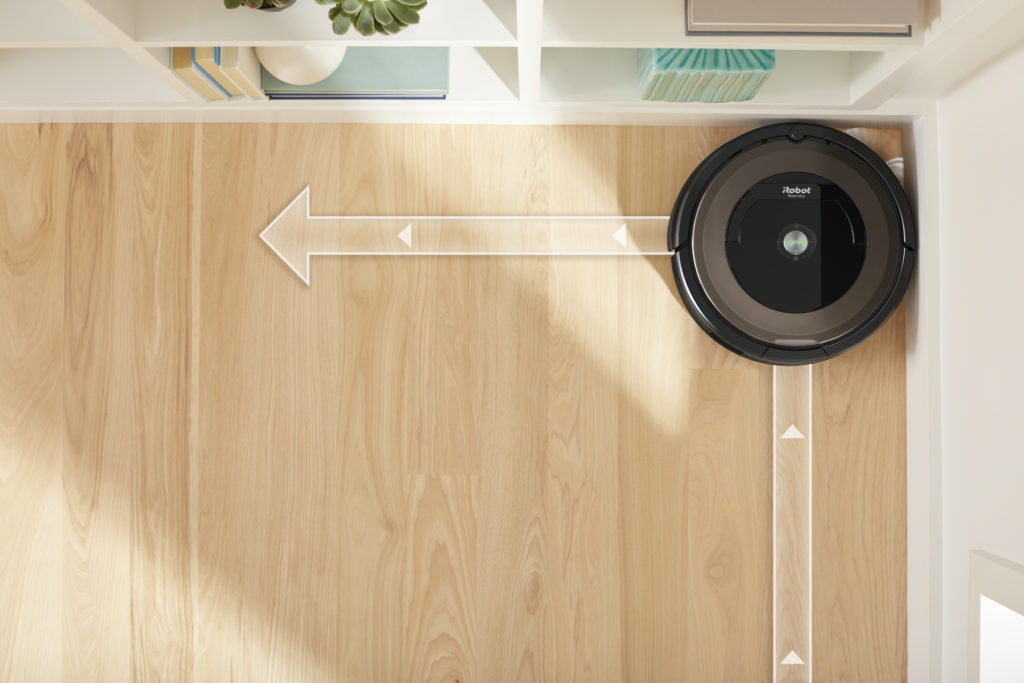
2. Filters
One of the differences in the two models is the filter used while cleaning. The Roomba 690 uses an AeroVac filter that claims to collect dirt, dust and pet hair efficiently. By all reports and testing, it does.
However, the Roomba 890 takes it one step further and uses a HEPA anti-allergen filter. This filter also collects dust, dirt, debris, and hair, but it also collects pollen and allergens down to 10 microns in size.
Bottom Line: If you or a family member has severe allergies then the HEPA filter in the Roomba 890 will benefit you most.
3. Extractors
The extractors, or beater bars, are the small bars under the vacuum that loosen, lift and break down the debris for collection. The 690 uses bristle brush bars that rotate in opposite directions to collect the dirt.
The 890 model uses brush-less extractor bars that do a slightly better job at picking up dirt and debris. The fact that there are no brushes also means less maintenance time for you. Less hair and strings will get caught or tangled around the debris extractors in the 890.
It is not to say it won’t happen. Anytime you have rotating bars picking up long hairs something will get snagged and wrapped. However, when it happens on the 890, the clean up will be a lot simpler. You won’t have to fight bristles and tangles and can usually wipe the wrapped hair and strings off without much effort.
Bottom Line: The brush-less extractors of the 890 is a significant advantage over the bristle brush extractors of the 690.
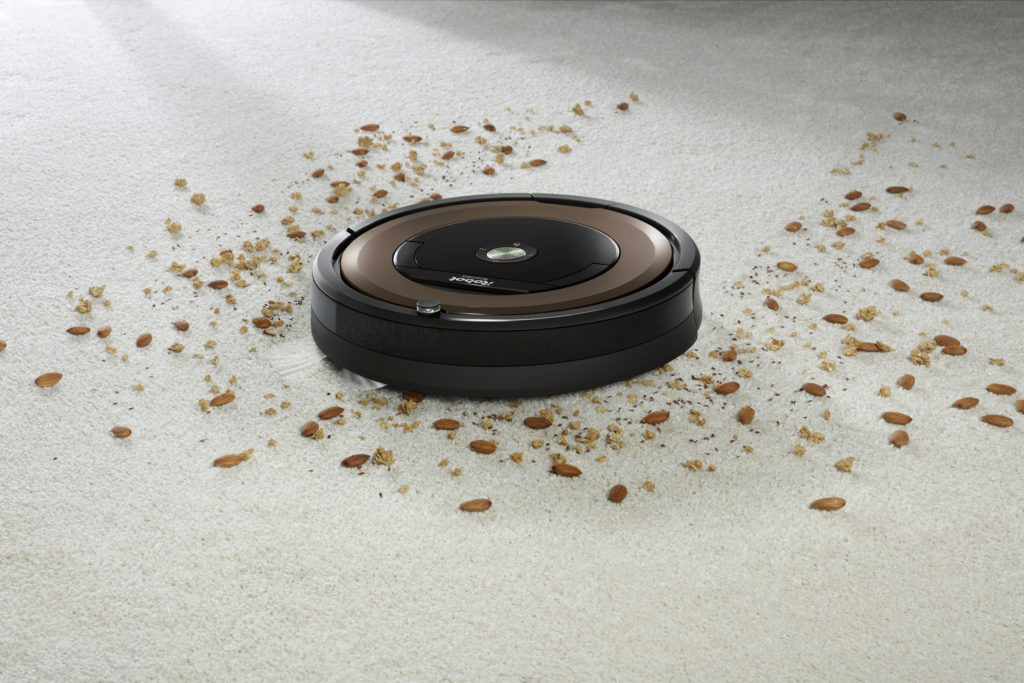
4. Scheduling
Each of the models represented in this review has the ability of scheduling. You can use the iHome app and set up a cleaning schedule that best suits your needs.
A lot of people report that they like to schedule their cleaning for when they will be away from home, such as at work and school or off for a day at the beach. Coming home to clean floors is nice, and you won’t be disturbed by the vacuum when you are trying to watch television.
The schedule allows you to set a date and time up to once per day for seven days. You can create a schedule by using the buttons on the top of the robot vacuum itself, or with these two models, you can also utilize the iHome app to create and manage your schedules.
If you create a schedule and wish to cancel it, you can also delete schedules just as easy as you create them. It should be noted though if you are away from home during a scheduled cleaning, you should make a run through and pickup anything that may cause damage to the vacuum or get in the way causing a remapping.
Items such as clothes or towels on the floor, toys and anything you don’t want to be picked up, like juniors Lego collection, should be removed from the path of the vacuum. You can also set up the virtual wall barrier to prevent access to a room that is usually gone over.
Bottom Line: A Tie. Scheduling is a great way to maintain your home cleaning while you are away from home.
5. Recharging and Force Docking
Each unit has a monitor on board for its battery life. When the battery becomes too low to continue cleaning the robot will automatically return to the docking station to recharge.
You can also use the iHome app or the buttons directly on the unit to force it to stop the cleaning cycle and return to the dock.
One disadvantage to the automatic recharging ability is that it will not resume cleaning until you tell it to do so. If you have a cleaning scheduled for when you are away, and the battery runs low, you may come home to find your little guy in the docking station and the floors not 100% covered. Auto-resume is a feature found only in the 900 series.
Bottom Line: A Tie. Both models will auto-dock when low on battery. Both models are not able to resume cleaning automatically though, so you may be left with a partially vacuumed floor.
6. Lithium-Ion Batteries
Another similarity in the Roomba 690 and 890 is the reliance on lithium-ion batteries. These batteries are a great upgrade over the older style Nickle Metal Hydride (NiMH) type.
Lithium-Ion will last longer and recharge faster than NiMH batteries and will also hold more complete charge cycles. To you, this means more time cleaning and less time charging as well as less money spent replacing batteries over the life of the vacuum.
Bottom Line: Lithium-Ion batteries are far superior to NiMH batteries, and it is great to see their inclusion in these two models.
7. iHome App
With wireless connectivity, you can take advantage of the iHome app on your cell phone. There is a version for both iPhone and Android cell phones and tablets.
The free app allows you to connect to your WiFi-enabled Roomba vacuum to set schedules, start and stop a cleaning cycle and even name your robot. With the app, you will have total control over every aspect of the unit no matter where you are.
As long as you have WiFi connected in the home and the Roomba is connected to the network, you can use the app at any time from any place to have your floors maintained.
Bottom Line: Both models support the app, which is a nice-to-have feature that allows you to have a fully automated smart home, or start one with the Roomba vacuum line.
8. Voice Controls
Yet another similarity is the ability for these two units to be controlled with smart home voice control options such as Amazon Alexa and Google Assistant.
You can tell Alexa to start, stop pause or resume a cleaning job. You can also check on the status of the unit and find the robot should it become lost.
You can say things to Alexa or Google such as: “Ok Google, tell Roomba to start cleaning.” or “Alexa, ask Roomba to resume cleaning.”
Some homes have two or more Roomba vacuums. In this instance, you will need to name your robots different names and use their names when using voice control. Such as: “Ok Google, ask Roomba to send Marvin home.” (You will need to change “Marvin” to whatever name you give your robot… but Marvin is a good, strong name; we suggest you use it.)
Bottom Line: Both models have it.Voice control is a great tool when you can’t get to your phone (say if it is charging or lost).
9. Virtual Wall Barriers
The final similarity is the use of the iRobot virtual wall barriers (VWB). These little devices send out an infrared signal that prevents the Roomba from getting past. When the Roomba senses the beam, it will adjust its path to avoid that space.
One advantage to this is the ability to set up a radius (up to three feet) that will protect items around the barrier. You can use this around smaller table legs, for example, that the Roomba may continuously run in to. Or around water bowls and plants that may spill or get knocked over if hit by the vacuum.
Bottom Line: The virtual wall barriers are a great extension of the Roomba family and allow you to have further control over the areas you want to be cleaned.
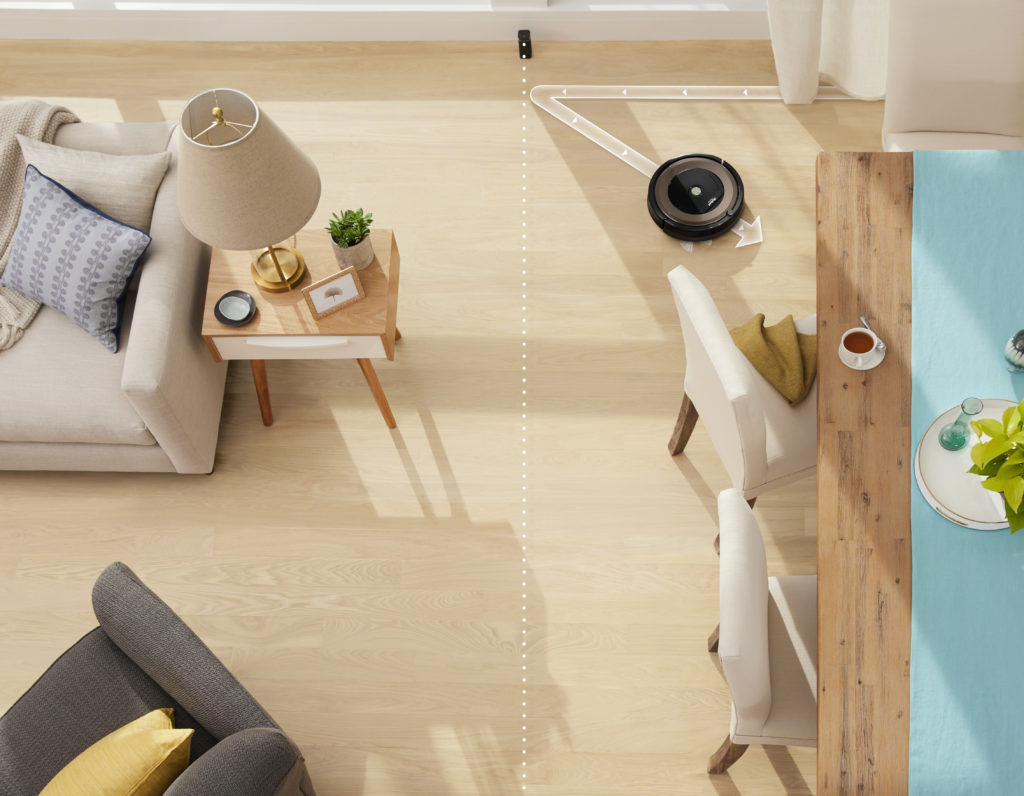
10. AeroVac vs AeroForce
Don’t be confused by the trademark names. They are fancy marketing terms and are not actually all that important. The technology between the two is mostly similar. Think of AeroForce as an upgrade to the AeroVac tech.
AeroVac is the original technology behind iRobot’s three stage cleaning system. This is the technology that the Roomba 690 uses. The first stage is the sensors that detect the debris, stairs and edges. The second stage is the motor and air flow channel that collects the dirt and debris. The third stage are the brushes and extractors.
With the 800 series moving forward, iRobot changed from AeroVac to AeroForce. The upgrades in this technology include:
- Brush-less debris extractors that boast a tangle-free cleaning experience.
- Accelerated air flow through the collection chamber with up to 5 times the power.
- The ability to work on all floor types, including shag carpeting.
- Tangle-free collection where the robot will sense cords or fringe being suctioned into the chamber and reversing the extractors to free itself.
Bottom Line: The 890 has an upgrade cleaning system from the more basic AeroVac system found on the 690.
Review of the Roomba 690
The Roomba 690 is a very efficient cleaning robot. With the addition of the WiFi and iHome app support, you have more control over the vacuum than all other 600 series models. If your budget is a little tighter, the 690 might be the best option for you.
Where price is concerned, the 690 is cheaper than the 890. However, you do lose a bit of functionality with the lower price tag. You will have increased maintenance on the machine as well.
The 690 does not offer a way for you to know the collection bin is full. For you, this means that you will have to check the bin regularly and empty it when needed. That being said, once you run the vacuum for a few months, you will have a good idea of when the bin is full and can change it on a regular schedule.
The motor in the 690 provides enough suction to do a great job cleaning your floors. The AeroVac system is a decent advancement in floor cleaning which allows the 690 to clean your floors fairly well.
You shouldn’t notice any major differences in the cleaning ability of the 690 over any other Roomba model, but you may need to use the spot cleaning function more often. This isn’t a bad thing though; the Roomba 690 is the only 600 series cleaner to offer spot cleaning mode.
The only real downside to the 690 model is the rotating brush bars. While they do an excellent job of picking up hair, debris, and dirt from the floors, you will have to clean them fairly regularly. Because they have bristles, hair will become tangled and can be difficult to remove.
This is not uncommon, as most upright vacuums have the same issue. You will need to regularly inspect your robot and have a maintenance schedule that you stay on top of. In our experience, regular maintenance and cleaning will take between 15 and 20 minutes, if done twice a month.
If you suffer from allergies, then it might be a better option to seek out a Roomba model that offers the HEPA filter. The AeroVac filters are excellent at blocking dust debris and pet hair but lack the anti-allergen filtration the HEPA filters do.
All in all, the Roomba 690 is a great value for the money. It will do an excellent job cleaning your floors in a worry-free and automated manner. As long asyou don’t mind a little more maintenance and the lack of allergen filtration, the 690 is a good choice.
Review of the Roomba 890
If your budget is a little more relaxed and you want to opt for a few upgrades, the Roomba 890 is a solid choice over the 690 and has a few features that might be worth it to you for the extra cost.
One of the major upgrades is the use of the AeroForce vacuum technology. This gives the robot a little more power in the motor, and the three-stage cleaning will have a marked improvement on your floors. You will notice less spot cleaning and a more efficient run through the area than with the 690’s AeroVac system.
Of course, the WiFi and iHome connectivity are huge bonuses that the 690 also utilizes. With the 890 though, you are less likely to need additional cleaning cycles between the scheduled runs. The better motor speed and the debris extractors do a fantastic job at collecting all the pet hair, dirt, dust and debris from your entire floor.
The full bin indicator is also a nice touch. You may know that the little guy can run twice through your home before the bin is full, but you may not have noticed the extra dirt tracked in last night that filled it up sooner. Knowing the bin is full without having to check manually is a nice plus.
With the lithium-ion batteries and auto recharge, the Roomba 890 will quickly be able to resume its cleaning mission. One downside is that it won’t do this automatically. Once the batteries are charged, you will have to tell the vacuum to continue cleaning manually.
You can do this through the push button on top of the robot or by using the clean option in the iHome app. You can also block the robot from entering an area or disrupting a space with the virtual wall barrier.
These barriers act as a gate that prevents the vacuum from leaving or entering a different room. You can also set up a radius zone that the robot will avoid. This is useful around pet food and water dishes, potted plants or even end tables that may be collided with.
You will pay a little more for the Roomba 890 over the 690, but with the advancements in the cleaning technology and the small extras that come with it, you will be happy you did.
Frequently Asked Questions
Here, we attempt to answer the most important questions you may have about the Roomba vacuums.
Q: Do I need wifi in my house to use these Roombas?
Wifi is not required, you can use the onboard controls to run both the 690 and 890. However, if you don’t have wifi and don’t foresee ever installing it, getting a non-connected Roomba (like the Roomba 614 might be cheaper).
Q: Will the Roomba get caught on cords and carpet fringe?
Any time you have moving parts, suction and loose items, something is bound to get caught or tangled. However, with the Roomba 890 and the AeroForce technology, the robot will attempt to free itself.
If it cannot (or in the case of the 690) if it does get tangled it will shut down and give you an error message to prevent damage to the motor and depletion of the batteries.
Q: I’ve heard that the Roomba won’t clean dark colored flooring.
That isn’t a question. However, there have been reports that Roombas have some difficulty on black or dark colored areas of flooring. This is due to the sensors not being able to detect if the dark is a drop off, or in some cases if there is any dirt there.
If you notice your robot avoiding dark areas it may be a depth perception issue. You can physically move the vacuum over the area and see if it will clean then. In most cases, unless the dark area is in direct contrast to surrounding areas, it won’t have a problem cleaning.
Q: We have expensive luxury flooring, will the Roomba damage them?
No. First when you name your robot give it a Royal sounding name like Queen Bot or Your Highness. It will then tip toe over the delicate flooring to avoid scratches.
In reality, the wheels on the Roomba are designed to not scratch any type of flooring and we haven’t been able to prove they ever have, so far.
Q: The Roomba cleaned a room I didn’t want it too, how can I prevent this?
Scold it with a wagging finger and send it back to the docking station to sulk. Then you can either block off the area by shutting a door, or better yet make use of the Virtual Wall Barrier and block off the entrance to the room using the infrared beam.
The Virtual Wall Barrier is the preferred method, especially if you want the room cleaned in the future. Even if only sometimes. If you close a door and the robot has already mapped the space, it will count it as a new obstacle and remap your floor, avoiding the area moving forward. With the virtual wall, you can turn access to that room on and off as you see fit.
Q: Will the Roomba transition between hardwood floors and thick braided rugs?
Yes, it will. The wheels on the robotic vacuums are designed for almost every possible floor type. You should have little issue with your Roomba going from one to the other.
It should be noted though, that the color of the flooring and rugs may cause the robot to sense it as an edge. It may not get on the rug or it may not get off. If this happens the vacuum will spin and then signal that it is trapped (you will need to mount a daring rescue).
Q: Will the Roomba mark or mar my white baseboards?
The answer is: not likely. However, most interior paints are oil based and thus dry thoroughly, preventing the Roomba from making a mark as it comes into contact. If you have a latex based paint it could stay “tacky” and “wet” for several years. In this instance, marring or marking has been observed.
If you can use your fingernail and move or wrinkle the paint on your baseboards then you have a latex based paint. However, the marks that have been reported wipe off fairly easily.
Q: My cat tracks kitty litter around the house, if I get a Roomba, will it help?
Removing the cat would help more. The Roomba might scare the cat enough to make it stop spreading litter around, but I highly doubt it.
The Roomba will pick up the kitty litter with absolutely no fuss or complaint though, which is a huge help.
Q: Does the Roomba automatically recharge when it it’s batteries are dead?
Blunt answer: No. It will need some power in the batteries to return to the socking station (which it will do on its own). However, if the batteries are already dead, it will have no motivation to get to the dock itself.
You may find your robot has died in the middle of the floor from time to time. If this happens you just use the built-in carrying handle and place it in the docking station to recharge. If it happens frequently, ensure the Roomba can locate the docking station.
You should have four feet of clearance straight in front of the dock and at least a foot and a half on either side to allow the unit to find the station on its own.
What We Like about The Roomba 690
- Lithium-Ion is better battery technology than the NiMH option from previous models.
- Automatic recharging is a great way to ensure your robot is always ready to go.
- The ability to remotely control the device using the iHome app is a huge bonus.
- Scheduling allows you to set it and come home to clean floors every day.
- Voice controls using Amazon Alexa, or Google Assistant means less hassle for you.
- The iHome app support gives you the ability to have your floors clean at any time, from anywhere.
What We Like about The Roomba 890
- Everything we like aboutthe 690 above, plus:
- HEPA filters allow allergy sufferers to breathe easy knowing 99% of the home’s allergens are collected.
- Brush-less extractors offer better collection and less fuss when doing routine maintenance.
The Bottom Line
No matter how you look at it, Roombas are a pretty good investment. Even if you only use them to help maintain the cleanliness between regular vacuuming, these guys will do a fantastic job.
If you are looking for easier control using a cell phone app or your voice while staying on a budget, the Roomba 690 might just be the option you need.It will keep your floors clean and give you little to worry about and all at a cost that can meet just about any budget.
If on the other hand, you want more features and don’t mind spending a little bit more up front, the Roomba 890 might be a wise choice. With HEPA filtration you don’t have to worry about allergies as much and can rely on the three-stage cleaning while you are away, knowing your floors will look amazing when you get home.
When it comes down to a choice between the cost-effective 690 and the added features of the 890, our choice would be to pay a little more and get the Roomba 890. Pound for pound this robotic vacuum will meet most all of your needs.
Click here for all the robot vacuum deals on Amazon today.

Does the 690 get into corners? Must we have WiFi in our home?
Hey Richard,
The 690 does TRY to get to clean the corners of your home, but due to its round shape, it WILL miss a small triangle (about 1.5 inches in length) in all the corners.
The spinning side brush tries its best but that does not get all the dirt.
In practical use, this doesn’t really present a big problem. As in, I didn’t notice a big pile of dust in the corners of my house.
You do not need WiFi in your home to use the 690, you can just press the big clean button on the Roomba. However, you will miss out on features like scheduling.
If you are not planning on installing WiFi any time soon, I recommend going with the cheaper Roomba 614 (no Wifi capabilities).
Great review, thanks.
Does it scratch hardwood floors?
Hi Louisa,
Thanks for your kind words. The 690 uses traditional rolling brushes and the 890 uses rubber rollers.
If your floors can withstand normal upright vacuums, they will be ok to use with these Roombas.
Thanks for you help. It was exactly what I was looking for and needed.